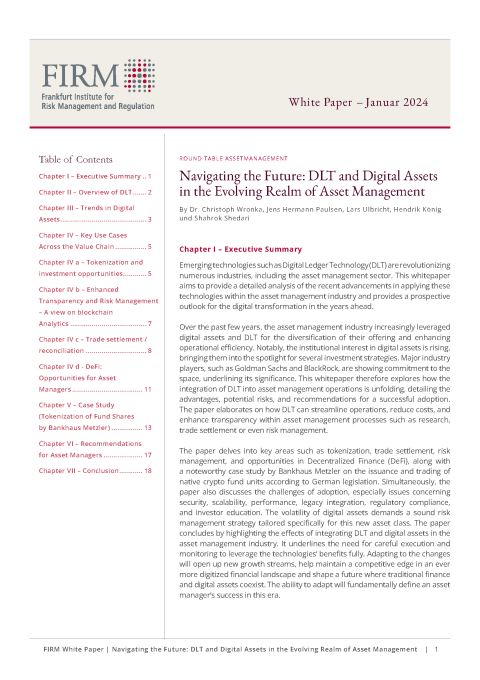Whitepaper
Asset Management
Navigating the Future: DLT and Digital Assets
in the Evolving Realm of Asset Management
Emerging technologies such as digital ledger technology (DLT) are revolutionizing numerous industries, including the asset management sector. This white paper analyzes the latest advances in the application of these technologies in asset management and provides an outlook on the digital transformation in the coming years.
The wealth management industry is increasingly using digital assets and DLT to diversify its offering and improve operational efficiency. Institutional interest in digital assets in particular is on the rise, putting them in the spotlight for various investment strategies. The commitment of industry giants such as Goldman Sachs and BlackRock underlines the importance of this trend.
This white paper examines the integration of DLT into asset management, describing the benefits as well as the potential risks. Recommendations for a successful introduction are also given. It shows how DLT can rationalize processes, reduce costs and create transparency within asset management processes, in research, trade processing and risk management.
The paper addresses key areas such as tokenization, trade settlement, risk management and the possibilities of decentralized finance (DeFi). A case study by Bankhaus Metzler on the issue and trading of native crypto fund shares under German law will also be shown. The authors provide an outlook on the impact of the integration of DLT and digital assets on the asset management industry.
Authors: Dr. Christoph Wronka, Jens Hermann Paulsen, Lars Ulbricht (all Deloitte) as well as Hendrik König and Shahrok Shedari (both Bankhaus Metzler)
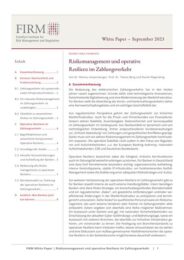
Payments
Risk management and operational
resilience in payment transactions
The importance of electronic payments has increased rapidly in recent years. The reasons for this are technological innovations, advancing digitalization and modernization of the market infrastructure. For banks, the processing of account and card payment transactions therefore represents a core value chain and an important business segment.
The position paper highlights the challenges that banks currently face in payment traffic. To this end, the Round Table conducted a survey among FIRM member institutions, surveyed the status quo, and developed important internal and external recommendations for action.
Authors: Dr. Markus Ampenberger (BCG), Prof. Dr. Tobias Berg (Goethe University), Daniel Regending (Deutsche Bank)
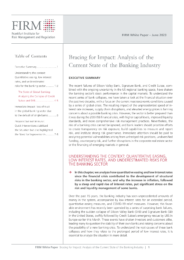
Macroeconomics
Bracing for Impact: Analysis of the
Current
State of the Banking Industry
Uncertainty remains high following the recent bank failures of Silicon Valley Bank, Signature Bank and Credit Suisse. Is there a danger of a renewed crisis? The risk should not be underestimated, write the authors of the current FIRM position paper. According to their assessment, however, the banks are better prepared than in the financial crisis of 2007/2008.
FIRM CEO Gerold Grasshoff, together with co-author Dr. Til Bünder (BCG), has spent the last few months intensively studying the developments on the
Banking market busy. “You have to go way back to understand the context in which current developments are taking place,” Grasshoff explains. The banking sector has been fed with cheap money over the past 15 years, through low interest rates over a very long period and through quantitative easing.
Authors: Gerold Grasshoff (FIRM) and Dr. Til Bünder (BCG)
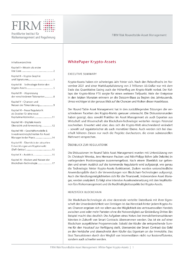
Asset Management
Cryptoassets
Crypto assets have had a difficult year. After hitting record highs in November 2021 and a market capitalization of $3 trillion, the end of quantitative easing also marked the end of the highs in the crypto market. The collapse of the crypto exchange FTX provided another low point. Many of the events in recent months are reminiscent of the dotcom bubble at the beginning of the millennium. This makes it all the more important to take a close look at the opportunities and risks of this asset class.
In past meetings, the Asset Management Round Table has taken a closer look at the various facets of the crypto market. The discussion panels showed that both asset management practitioners and experts from business and academia continue to see huge potential in blockchain technology. However, it is expected that the crypto world will undergo drastic changes
– both at the regulatory and monetary level.
Authors: Christoph Wronka, Jens Paulsen and Nils-Philipp Böhm (all Deloitte)
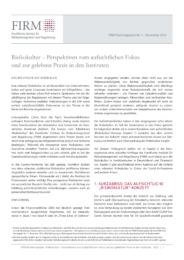
Risk culture
Perspectives on the supervisory focus and the lived practice in the institutes
A robust risk culture is a success factor as part of corporate culture and good corporate governance – many banks recognized this early on. At the latest with the regulators’ preoccupation with this topic and the consequent
inclusion of explicit requirements in the CRR and other regulatory documents, the topic has become widespread in the industry.
Leadership culture (“tone from the top”), responsibilities, effective communication and critical dialogue, and incentives: these core building blocks of risk culture are now established as a theoretical construct. The “Risk Culture” working group of the Frankfurt Institute for Risk Management and Regulation (FIRM) has derived ten theses from this.
Whitepaper
Asset Management
Navigating the Future: DLT and Digital Assets
in the Evolving Realm of Asset Management
Emerging technologies such as digital ledger technology (DLT) are revolutionizing numerous industries, including the asset management sector. This white paper analyzes the latest advances in the application of these technologies in asset management and provides an outlook on the digital transformation in the coming years.
The wealth management industry is increasingly using digital assets and DLT to diversify its offering and improve operational efficiency. Institutional interest in digital assets in particular is on the rise, putting them in the spotlight for various investment strategies. The commitment of industry giants such as Goldman Sachs and BlackRock underlines the importance of this trend.
This white paper examines the integration of DLT into asset management, describing the benefits as well as the potential risks. Recommendations for a successful introduction are also given. It shows how DLT can rationalize processes, reduce costs and create transparency within asset management processes, in research, trade processing and risk management.
The paper addresses key areas such as tokenization, trade settlement, risk management and the possibilities of decentralized finance (DeFi). A case study by Bankhaus Metzler on the issue and trading of native crypto fund shares under German law will also be shown. The authors provide an outlook on the impact of the integration of DLT and digital assets on the asset management industry.
Authors: Dr. Christoph Wronka, Jens Hermann Paulsen, Lars Ulbricht (all Deloitte) as well as Hendrik König and Shahrok Shedari (both Bankhaus Metzler)

Payments
Risk management and operational
resilience in payment transactions
The importance of electronic payments has increased rapidly in recent years. The reasons for this are technological innovations, advancing digitalization and modernization of the market infrastructure. For banks, the processing of account and card payment transactions therefore represents a core value chain and an important business segment.
The position paper highlights the challenges that banks currently face in payment traffic. To this end, the Round Table conducted a survey among FIRM member institutions, surveyed the status quo, and developed important internal and external recommendations for action.
Authors: Dr. Markus Ampenberger (BCG), Prof. Dr. Tobias Berg (Goethe University), Daniel Regending (Deutsche Bank)

Macroeconomics
Bracing for Impact: Analysis of the
Current
State of the Banking Industry
Uncertainty remains high following the recent bank failures of Silicon Valley Bank, Signature Bank and Credit Suisse. Is there a danger of a renewed crisis? The risk should not be underestimated, write the authors of the current FIRM position paper. According to their assessment, however, the banks are better prepared than in the financial crisis of 2007/2008.
FIRM CEO Gerold Grasshoff, together with co-author Dr. Til Bünder (BCG), has spent the last few months intensively studying the developments on the
Banking market busy. “You have to go way back to understand the context in which current developments are taking place,” Grasshoff explains. The banking sector has been fed with cheap money over the past 15 years, through low interest rates over a very long period and through quantitative easing.
Authors: Gerold Grasshoff (FIRM) and Dr. Til Bünder (BCG)

Asset Management
Cryptoassets
Crypto assets have had a difficult year. After hitting record highs in November 2021 and a market capitalization of $3 trillion, the end of quantitative easing also marked the end of the highs in the crypto market. The collapse of the crypto exchange FTX provided another low point. Many of the events in recent months are reminiscent of the dotcom bubble at the beginning of the millennium. This makes it all the more important to take a close look at the opportunities and risks of this asset class.
In past meetings, the Asset Management Round Table has taken a closer look at the various facets of the crypto market. The discussion panels showed that both asset management practitioners and experts from business and academia continue to see huge potential in blockchain technology. However, it is expected that the crypto world will undergo drastic changes
– both at the regulatory and monetary level.
Authors: Christoph Wronka, Jens Paulsen and Nils-Philipp Böhm (all Deloitte)

Risk culture
Perspectives on the supervisory focus and the lived practice in the institutes
A robust risk culture is a success factor as part of corporate culture and good corporate governance – many banks recognized this early on. At the latest with the regulators’ preoccupation with this topic and the consequent
inclusion of explicit requirements in the CRR and other regulatory documents, the topic has become widespread in the industry.
Leadership culture (“tone from the top”), responsibilities, effective communication and critical dialogue, and incentives: these core building blocks of risk culture are now established as a theoretical construct. The “Risk Culture” working group of the Frankfurt Institute for Risk Management and Regulation (FIRM) has derived ten theses from this.

